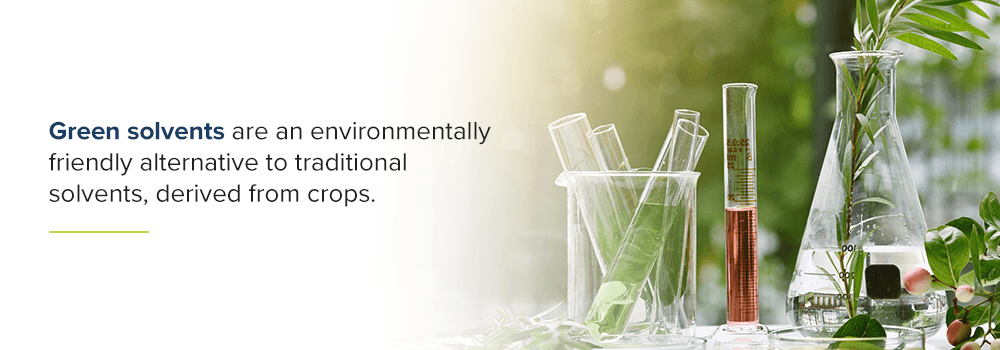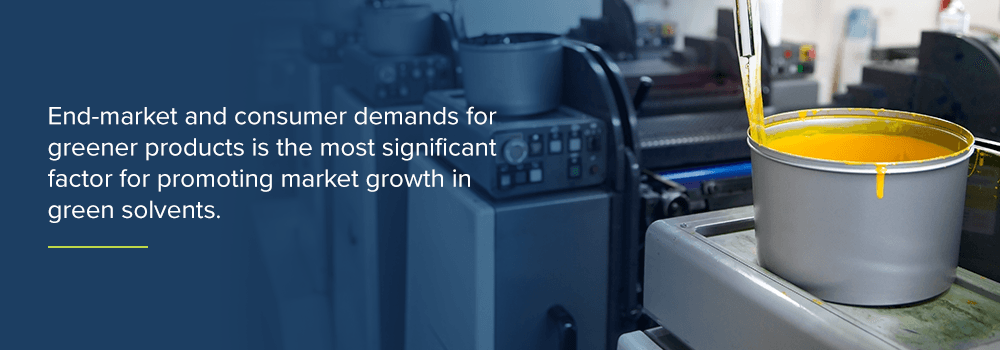The Increasing Demand for Bio-Based Solvents

The market for bio-based solvents has been growing for years. A solvent is any substance that dissolves a solute, such as acetone, methanol and hexane. Solvents are common in engineering, construction, pharmaceuticals, printing and various other industries. Bio-based solvents derive from living matter, such as plants and animals. In response to human health and environmental sustainability concerns, scientists began developing “green” or bio-based solvents. You may also see them called “agrochemicals.”
Green solvents consist of beets, sugars, corn and other products. Bio-based solvents act as a replacement for crude oil-based solvents. They are as effective and often safer than their counterparts. Thanks to their higher boiling point, low toxicity, recyclability, low miscibility and unique other features, sustainable solvents are getting a lot of attention. One of the main advantages of green solvents is that they release fewer volatile organic compounds during manufacturing compared to petroleum-based solvents. Green solvents are popular thanks to their many uses and their versatility.

What Are Green Solvents?
Green solvents are an environmentally friendly alternative to traditional solvents, derived from crops. For example, a green solvent called ethyl lactate is a byproduct of corn processing. It works well as a coating for wood, metals and other substances, replacing lactate ester. It also makes an effective paint stripper and cleaner for metal surfaces.
Such natural solvents serve many purposes including making workplaces safer, limiting worker exposure to harmful chemicals. They improve security in homes and buildings by limiting the amount of airborne chemical compounds released from coated surfaces, such as furniture and floorboards. They also help minimize the environmental harm of manufacturing processes.

What Are Green Solvents Used In?
Sustainable solvent suppliers are seeing increased demand for bio-based solvents, which are beneficial across hundreds of different industries. Green or bio-based solvents offer a wide range of practical uses, including the following.
- Coatings: Many products require protective coatings to ward against rot, insects, rain, moisture and other outside factors. Some traditional petrochemical coatings can result in released VOCs, presenting a long-term safety hazard. Green solvents are a safer alternative for coatings on furniture, wood floors and other surfaces.
- Paints: Chemicals are necessary for creating paint pigment, resin and consistency. Some chemicals in paints present human health concerns, so replacing them with bio-based solutions can promote safety.
- Paint strippers: Green solvents can also remove paint from surfaces without using harsh gasoline- or acetone-based chemicals.
- Printing inks: Printer ink also contains some potentially harmful chemicals, many of which are replaceable with bio-based alternatives.
- Cosmetics: Using oleochemicals for cosmetics is gentler on the skin and safer for long-term health. Bio-based cosmetic ingredients include palm oil, coconut oil, soybeans, corn and some bacteria.
- Personal care products: Many personal care product companies are replacing synthetic chemicals with bio-based alternatives. Examples include hair care products, soaps, shaving creams and other everyday care products.
- Sealants: Sealants and adhesives are necessary in various industries, and their composition can impact human and environmental safety.
- Pharmaceuticals: Pharmaceuticals rely on safe, sustainable ingredients more than any other industry. Many pharmaceutical companies are turning to green solvents for their products.
What Are the Most Popular Uses of Bio-Based Solvents?
Though bio-based solvents have many uses, some are in higher demand than others. Paints and coating are the most popular use, due to housing construction projects around the world. As customers’ appetite for more sustainable products increases, it will compel manufacturers to purchase environmentally friendly ingredients and components, including green solvents. Sustainable solvents are beneficial in manufacturing, construction, cosmetics manufacturing and many other industries.
How Mainstream Are Bio-Sustainable Solvents?
The bio-based market has seen continued growth. By 2018, the global market reached $4.2 billion. Experts predict the market will grow by 7% each year, hitting $5.9 billion by 2023. Market segments include:
- Bio-alcohols
- Bio-glycols
- Bio-diols
- Ethyl lactate
- D-limonene
- Methyl soyate
What Segments Are Growing the Fastest?
One of the fastest-growing segments is methyl soyate. As its name suggests, it comes from soy oil and methanol. It serves as biodiesel fuel and as an industrial solvent. As a fuel replacement, the green solvent could reduce global air and water pollution and improve outdoor air quality for human health.
While methyl soyate is gaining market share, many manufacturers choose bio-based ethanol because of its versatility and its widespread commercialization, making it more affordable and convenient to purchase. Ethyl lactate is also a green solvent that’s growing in popularity, used as a replacement for petroleum solvents.
What Applications Are in Highest Demand?
Though the methyl soyate segment is booming, the most widespread application for green solvents is industrial and domestic cleaning. In industrial settings, bio-based cleaners keep mechanical parts free of damaging dirt particles, ensuring the equipment’s efficiency and longevity. For homeowners, bio-based cleaners help keep kitchens, bathrooms and shared surfaces free from dirt with minimal risk to human safety — some traditional cleaning products present safety concerns after long-term exposure.
What Region Has the Most Significant Market Share?
North America has remained the leader in the green solvent market. It leads in demand, product innovation, and new application innovation. The most dominant market shareholder is the United States, followed by Canada and Mexico. The bio-based solvent market continues to grow throughout North America. Other leading market players are Germany, the Netherlands, India, and Italy. These nations are expressing increased interest in developing, producing, and marketing green solvent solutions.

Why Is the Market Growing?
End-market and consumer demands for greener products is the most significant factor for promoting market growth in green solvents. Across nearly all industries, consumers are beginning to place an unprecedented level of responsibility on the brands they buy from, expecting cleaner and safer products.
Increased Concern for the Environment, Health and Safety
Part of the reason the United States claims such a significant portion of the green solvent market is that more American consumers than ever are environmentally conscious. About three-quarters of Americans claim they are particularly concerned about the environment. Over 80% say they make an effort to live in ways that will help protect the environment some or all the time — one of the ways they do so is through their purchase decisions.
Around the world, people are also growing increasingly concerned about the chemicals found in everyday products and how those will affect their short- and long-term health. For instance, the Environmental Protection Agency cites a long list of potential side effects from VOC exposure. For these reasons, consumers are actively seeking safer, healthier alternatives to traditional products.
What Challenges Face the Industry?
Though the green solvent industry is expanding, it will have to face specific challenges. As a relatively new product market, it’s up against the well-established solvent industry. Petroleum-based solvents are mass-produced, inexpensive and accessible. Feedstock costs and more complex manufacturing affect green solvents’ price and availability.
However, as green solvents become more commercialized, more manufacturers might choose them over less sustainable alternatives. Already, manufacturers and researchers are seeking ways to make water-based and green solvents more commercially available. These innovations will likely shape the market in the years to come.

Contact Acme-Hardesty to Learn More
Acme-Hardesty is a leading distributor of oleochemicals, backed by more than 75 years of expertise. Currently focused on developing green solutions for customers, Acme-Hardesty is the choice of many manufacturers seeking oleochemicals, cosmetic oleochemicals, castor oils and derivatives, preservatives, surfactants, and palm derivatives. For more information on the benefits of green solvents, contact us today.
